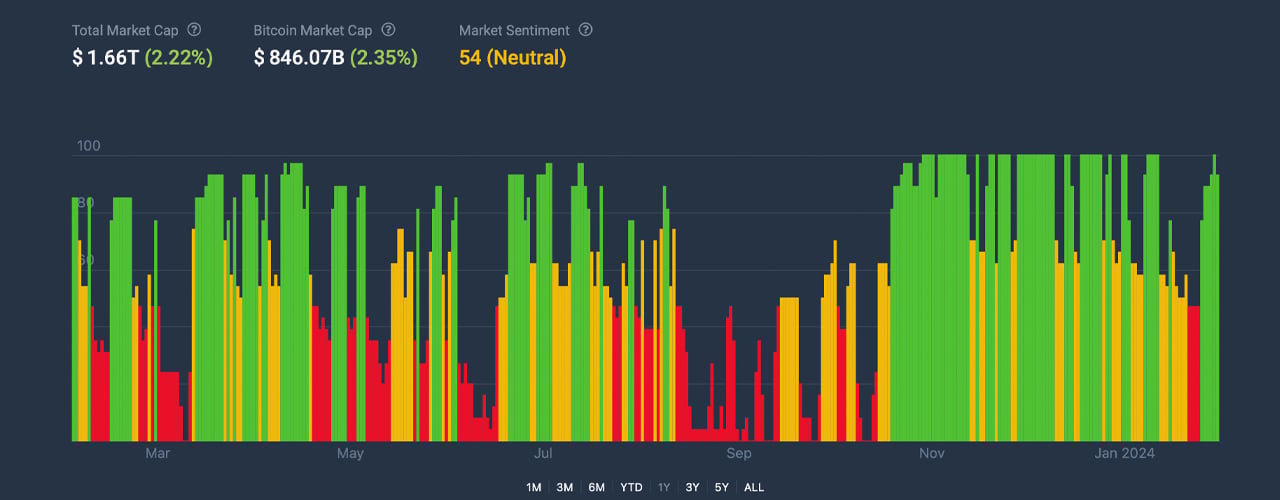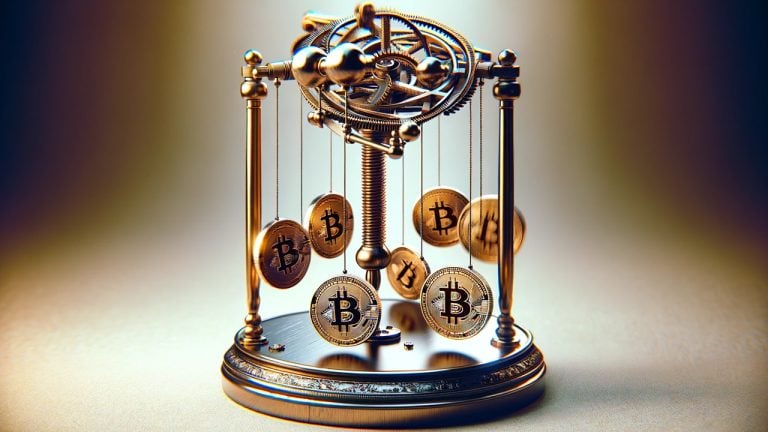
Bitcoin's Volatile Price Movement
On Friday, the price of bitcoin experienced significant fluctuations, ranging from $41,937 to $43,347. Despite the volatility, its market value reached an impressive $846 billion. The trading activity for the day amounted to $17.35 billion, indicating increased investor participation and market liquidity. However, as the weekend approached, these factors tend to diminish.
Current Sentiment towards Bitcoin
The sentiment towards bitcoin (BTC) is currently balanced, with a sentiment score of 54. Investors exhibit cautious optimism, straddling the line between bullish and bearish expectations based on technical analysis. The Crypto Fear and Greed Index (CFGI) has recently fluctuated sharply, oscillating between levels that indicate "greed" and a return to a "neutral" state.
Mixed Market Sentiment
Several market oscillators, including the relative strength index (RSI), Stochastic, and commodity channel index (CCI), reflect mixed feelings among market participants. The RSI, at a neutral point of 54, mirrors this sentiment. The awesome oscillator suggests a bullish outlook, while the momentum indicator suggests bearish tendencies, highlighting the polarized sentiment in the market.
Bullish Moving Averages
Moving averages (MAs) across different time frames consistently indicate bullish prospects for bitcoin. Both simple moving averages (SMA) and exponential moving averages (EMA) are ascending from the 10-day through the 200-day marker. This pattern demonstrates strong support for bitcoin's current valuation, despite the day's price swings. The daily chart reveals a significant price dip following the approval of spot bitcoin exchange-traded funds (ETFs), followed by a substantial downturn and subsequent rebound.
Resistance Levels and Potential Trading Strategies
Bitcoin faces heavy resistance near $49,000, with prices currently fluctuating between $42,000 and $43,800. This indicates a tentative recovery phase without definitive signs of a trend reversal. The hourly chart shows reduced volatility and a slight upward trajectory, while the 4-hour chart provides a consolidated perspective with a mild upward trend. Traders may consider short-term strategies based on breakout or reversal patterns at these resistance levels.
Bullish Verdict: Market Resilience
An analysis of bitcoin's performance on Feb. 2, 2024, highlights its resilience in the face of market volatility. The observed price recovery, coupled with decent trading volume, reflects investor confidence and ongoing liquidity in the market. With moving averages signaling a bullish trend and the awesome oscillator suggesting bullish momentum, bitcoin demonstrates a solid foundation for price growth. The neutral RSI, along with positive momentum in the hourly and 4-hour charts, indicates underlying strength in bitcoin's market position.

Bearish Verdict: Market Caution
Despite bitcoin's display of resilience on Feb. 2, 2024, several indicators point to underlying market caution. The significant price drop depicted in the daily chart, followed by a hesitant recovery, suggests vulnerability to further sell-offs and the absence of a definitive bullish reversal. Mixed signals from oscillators, particularly the contrasting sell signal from the momentum indicator, reflect investor uncertainty and a divided market sentiment. The neutral RSI, combined with resistance levels that capped the day's gains, highlight the challenges that lie ahead for bitcoin.
Register your email here to receive weekly price analysis updates straight to your inbox. Share your thoughts and opinions on bitcoin's market action on Friday in the comments section below.
Frequently Asked Questions
What are the pros and cons of a gold IRA?
The main advantage of an Individual Retirement Account (IRA) over a regular savings account is that you don't have to pay taxes on any interest earned. This makes an IRA great for people who want to save money but don't want to pay tax on the interest they earn. There are some disadvantages to this investment.
You may lose all your accumulated savings if you take too much out of your IRA. The IRS may prevent you from taking out your IRA funds until you reach 59 1/2. You will likely have to pay a penalty fee if you withdraw funds from an IRA.
A disadvantage to managing your IRA is the fact that fees must be paid. Many banks charge between 0.5%-2.0% per year. Other providers may charge monthly management fees, ranging between $10 and $50.
Insurance will be required if you would like to keep your cash out of banks. Insurance companies will usually require that you have at least $500,000. You may be required by some insurers to purchase insurance that covers losses as high as $500,000.
If you choose to go with a gold IRA, you'll need to determine how much gold you want to use. Some providers limit the amount of gold that you are allowed to own. Others allow you to pick your weight.
It is also up to you to decide whether you want to purchase physical gold or futures. The price of physical gold is higher than that of gold futures. Futures contracts offer flexibility for buying gold. Futures contracts allow you to create a contract with a specified expiration date.
You'll also need to decide what kind of insurance coverage you want. The standard policy does NOT include theft protection and loss due to fire or flood. However, it does cover damage caused by natural disasters. You may consider adding additional coverage if you live in an area at high risk.
You should also consider the cost of storage for your gold. Storage costs are not covered by insurance. Additionally, safekeeping is usually charged by banks at around $25-$40 per monthly.
To open a IRA in gold, you will need to first speak with a qualified custodian. Custodians keep track of your investments and ensure compliance with federal regulations. Custodians can't sell assets. Instead, they must maintain them for as long a time as you request.
Once you've decided which type of IRA best suits your needs, you'll need to fill out paperwork specifying your goals. You should also include information about your desired investments, such as stocks or bonds, mutual funds, real estate, and mutual funds. You should also specify how much you want to invest each month.
After completing the forms, send them along with a check or a small deposit to your chosen provider. Once the company has received your application, they will review it and send you a confirmation email.
Consider consulting a financial advisor when opening a golden IRA. A financial planner can help you decide the type of IRA that is right for your needs. They can help reduce your expenses by helping you find cheaper alternatives to buying insurance.
How much should I contribute to my Roth IRA account?
Roth IRAs are retirement accounts where you deposit your own money tax-free. You cannot withdraw funds from these accounts until you reach 59 1/2. You must adhere to certain rules if you are going to withdraw any of your contributions prior. First, your principal (the deposit amount originally made) is not transferable. This means that you can't take out more money than you originally contributed. If you decide to withdraw more money than what you contributed initially, you will need to pay taxes.
The second rule says that you cannot withdraw your earnings without paying income tax. Also, taxes will be due on any earnings you take. Consider, for instance, that you contribute $5,000 per year to your Roth IRA. Let's say you earn $10,000 each year after contributing. The federal income tax on your earnings would amount to $3,500. You would have $6,500 less. Because you can only withdraw what you have initially contributed, this is all you can take out.
If you took $4,000 from your earnings, you would still owe taxes for the $1,500 remaining. You would also lose half of your earnings because they are subject to another 50% tax (half off 40%). So, even though you ended up with $7,000 in your Roth IRA, you only got back $4,000.
There are two types if Roth IRAs, Roth and Traditional. Traditional IRAs allow pre-tax contributions to be deducted from your taxable tax income. When you retire, you can use your traditional IRA to withdraw your contribution balance plus interest. There are no restrictions on the amount you can withdraw from a Traditional IRA.
A Roth IRA doesn't allow you to deduct your contributions. However, once you retire, you can withdraw your entire contribution plus accrued interest. There is no minimum withdrawal requirement, unlike traditional IRAs. You don't need to wait until your 70 1/2 year old age before you can withdraw your contribution.
Is gold a good choice for an investment IRA?
If you are looking for a way to save money, gold is a great investment. It's also a great way to diversify your portfolio. But gold has more to it than meets the eyes.
It has been used throughout history as currency and it is still a very popular method of payment. It is often called “the oldest currency in the world.”
But unlike paper currencies, which governments create, gold is mined out of the earth. It's hard to find and very rare, making it extremely valuable.
The supply and demand factors determine how much gold is worth. The strength of the economy means people spend more, and so, there is less demand for gold. This results in gold prices rising.
On the flip side, when the economy slows down, people hoard cash instead of spending it. This causes more gold to be produced, which lowers its value.
This is why gold investment makes sense for both individuals and businesses. If you have gold to invest, you will reap the rewards when the economy expands.
Also, your investments will earn you interest which can help increase your wealth. You won't lose your money if gold prices drop.
Can I keep a Gold ETF in a Roth IRA
You may not have this option with a 401(k), however, you might want to consider other options, like an Individual retirement account (IRA).
A traditional IRA allows contributions from both employee and employer. Another option is to invest in publicly traded corporations with an Employee Stockownership Plan (ESOP).
An ESOP gives employees tax advantages as they share the stock of the company and the profits it makes. The money you invest in the ESOP will be taxed at a lower rate than if it were directly held by the employee.
A Individual Retirement Annuity is also possible. With an IRA, you make regular payments to yourself throughout your lifetime and receive income during retirement. Contributions to IRAs don't have to be taxable
What is a Precious Metal IRA, and how can you get one?
A precious metal IRA allows for you to diversify your retirement savings in gold, silver, palladium and iridium. These precious metals are extremely rare and valuable. These metals are great investments and can help protect your financial future from economic instability and inflation.
Precious metals often refer to themselves as “bullion.” Bullion refers simply to the physical metal.
Bullion can be bought via various channels, such as online retailers, large coin dealers and grocery stores.
A precious metal IRA allows you to invest directly in bullion, rather than buying stock shares. You'll get dividends each year.
Unlike regular IRAs, precious metal IRAs don't require paperwork or annual fees. Instead, you only pay a small percentage on your gains. You can also access your funds whenever it suits you.
What is the cost of gold IRA fees
A monthly fee of $6 for an Individual Retirement Account is charged. This fee covers account maintenance fees, as well any investment costs that may be associated with your investments.
You may have to pay additional fees if you want to diversify your portfolio. These fees will vary depending upon the type of IRA chosen. Some companies offer free checking, but charge monthly fees for IRAs.
A majority of providers also charge annual administration fees. These fees are usually between 0% and 1%. The average rate per year is.25%. These rates are usually waived if you use a broker such as TD Ameritrade.
Statistics
- Instead, the economy improved, stocks rebounded, and gold plunged, losing 28 percent of its value in 2013. (aarp.org)
- If you take distributions before hitting 59.5, you'll owe a 10% penalty on the amount withdrawn. (lendedu.com)
- Gold is considered a collectible, and profits from a sale are taxed at a maximum rate of 28 percent. (aarp.org)
- If you accidentally make an improper transaction, the IRS will disallow it and count it as a withdrawal, so you would owe income tax on the item's value and, if you are younger than 59 ½, an additional 10% early withdrawal penalty. (forbes.com)
- (Basically, if your GDP grows by 2%, you need miners to dig 2% more gold out of the ground every year to keep prices steady.) (smartasset.com)
External Links
investopedia.com
- Do You Need a Gold IRA to Get Retirement?
- What are the Options Types, Spreads and Example. Risk Metrics
law.cornell.edu
- 7 U.S. Code SS7 – Designation boards of trade as contract market authorities
- 26 U.S. Code SS 408 – Individual retirement account
forbes.com
- Gold IRA: Add some sparkle to your retirement nest egg
- Understanding China's Evergrande Crisis – Forbes Advisor
wsj.com
- Saddam Hussein's InvasionHelped Uncage a Bear In 90 – WSJ
- Want to Keep Gold in Your IRA at Home? It's Not Exactly Lawful – WSJ
How To
Investing in gold or stocks
Gold investing as an investment vehicle can seem extremely risky these days. The reason behind this is that many people believe that gold is no longer profitable to invest in. This belief comes from the fact most people see gold prices falling due to the global economy. They believe they would lose their money if they invested gold. There are many benefits to investing in gold. Let's take a look at some of the benefits.
The oldest form of currency known to mankind is gold. It has been in use for thousands of year. It was used by many people around the globe as a currency store. Even today, countries such as South Africa continue to rely heavily on it as a form of payment for their citizens.
You must first decide how much you are willing and able to pay per gram to decide whether or not gold should be your investment. The first thing you should do when considering buying gold bullion is to decide how much you will spend per gram. If you don't know your current market rate, you could always contact a local jeweler and ask them what they think the price is.
Noting that gold prices have fallen in recent years, it is worth noting that the cost to produce gold has gone up. The price of gold may have fallen, but the production costs haven’t.
The amount of gold that you are planning to purchase is another important consideration when deciding whether or not gold should be bought. If you plan to buy enough gold to cover your wedding rings then it is probably a good idea to wait before buying any more. But, if your goal is to make long-term investments in gold, this might be worth considering. It is possible to make a profit by selling your gold at higher prices than when you purchased it.
We hope this article has given you an improved understanding of gold investment tools. We strongly recommend that you research all available options before making any decisions. Only then will you be able to make an informed decision.
—————————————————————————————————————————————————————————————-
Based on [POSTTITLE]
by [POSTAUTHOR]
Related posts:
 Bitcoin Price Analysis: Oscillators and Moving Averages Signal Bullish Trend
Bitcoin Price Analysis: Oscillators and Moving Averages Signal Bullish Trend
 Ethereum Market Analysis: Bearish Trends and Potential for a Bullish Reversal
Ethereum Market Analysis: Bearish Trends and Potential for a Bullish Reversal
 Bitcoin Technical Analysis: Bullish Trends Push Against Upper Resistance Limits
Bitcoin Technical Analysis: Bullish Trends Push Against Upper Resistance Limits
 Ethereum Price Analysis: Strong Bullish Trend Signals Potential for Further Price Appreciation
Ethereum Price Analysis: Strong Bullish Trend Signals Potential for Further Price Appreciation













